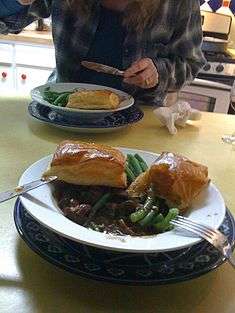Chestnut pie

Chestnut pie is a pie prepared with chestnuts as a primary ingredient. It is a part of the cuisine of Italy,[1] where it has been documented as dating back to the 15th century. It is also a part of the cuisine of the Southern United States.[2] Shelled whole or chopped chestnuts may be used, which may be boiled or roasted.[3] A chestnut purée may also be used.[2][4] It may be prepared as a savory or sweet pie.[5]
History
Chestnut pie has been documented back to the 15th century in Italy, in the book De honesta voluptate et valetudine ("On honourable pleasure and health") written by the Italian writer and gastronomist Bartolomeo Platina.[6] Platina's recipe, titled torta ex castaneís, called for the use of boiled and ground chestnuts in the pie.[6] The chestnuts were ground using a mortar and pestle, milk was added and then the mixture was strained.[6] After this step, the ingredients for a spelt tart were added.[6] The use of saffron was recommended to add coloration to the dish.[6]
In the 16th century, the pie was prepared and documented by Bartolomeo Scappi in his 1570 book Opera dell'arte del cucinare, which was focused upon Italian Renaissance cuisine.[6] The recipe included the use of dried and fresh chestnuts in the pie.[6] Scappi's recipe recommended using chestnuts that were not entirely ripened, gathered in August.[6]
An 1858 recipe for sweet chestnut pie uses chestnuts glazed with orange flowers, in the dish's preparation, which are placed inside the pie.[7]
A 1908 recipe for a savory chestnut pie uses shelled chestnuts, Spanish onion, haricot stock, salt and pepper.[8]
Savory chestnut pie
Savory chestnut pie may be prepared with various additional ingredients such as mushrooms, leeks, garlic[5] onion, celery,[9] leeks and butternut squash,[4] among others. A 1915 recipe uses boiled and shelled chestnuts, canned mushrooms, a white sauce and a biscuit dough in preparation of the dish.[10]
Sweet chestnut pie
Sweet chestnut pie may be prepared as a cream pie.[lower-alpha 1][2][12] Chocolate may be used as an ingredient in sweet chestnut pie.[3][13] It may be served topped with whipped cream.[2]
See also
Notes
References
- ↑ Viaggio in Toscana. Alla scoperta dei prodotti tipici. Ediz. inglese. Progetti educativi. Giunti Editore. 2001. p. 137. ISBN 978-88-09-02453-3.
- 1 2 3 4 Bryan, M.C. (2011). Mrs. Rowe's Little Book of Southern Pies. Potter/TenSpeed/Harmony. p. 53. ISBN 978-1-60774-135-0.
- 1 2 Costigan, F. (2013). Vegan Chocolate. Perseus Books Group. p. 160. ISBN 978-0-7624-4591-2.
- 1 2 Berry, Vava (December 12, 2013). "The new vegetarian: butternut-squash and chestnut pie". The Telegraph. Retrieved April 4, 2016.
- 1 2 Phillips, D. (2014). The Gourmet Jewish Cookbook: More than 200 Recipes from Around the World. St. Martin's Press. p. 163. ISBN 978-1-4668-4607-4.
- 1 2 3 4 5 6 7 8 Montanari, M.; Brombert, B.A. (2015). Medieval Tastes: Food, Cooking, and the Table. Arts and Traditions of the Table: Perspe. Columbia University Press. p. 115. ISBN 978-0-231-53908-1.
- ↑ The household encyclopædia; or, Family dictionary of everything connected with housekeeping and domestic medicine, by an association of heads of families and men of science. 1858. p. 283. Retrieved April 4, 2016.
- ↑ Black, G. (1908). A Manual of Vegetarian Cookery. Horace Marshall. p. 36.
- ↑ Allinson, T.R. (2010). The Allinson Vegetarian Cookery Book. Bod Third Party Titles. pp. 23–24. ISBN 978-3-86195-179-7.
- ↑ Good Health. Good Health Publishing Company. 1915. p. 570.
- ↑ Pennsylvania Nut Growers' Association (1972). The Nut Kernel.
- ↑ West, P.; Chew, M.; Fearnley-Whittingstall, H. (2015). The River Cottage Australia Cookbook. Bloomsbury Publishing. p. 461. ISBN 978-1-4088-5840-0.
- ↑ Publishing, Anness; McFadden, C.; France, C. (2000). Chocolate. Anness Publishing. p. 162. ISBN 978-1-84309-068-7.